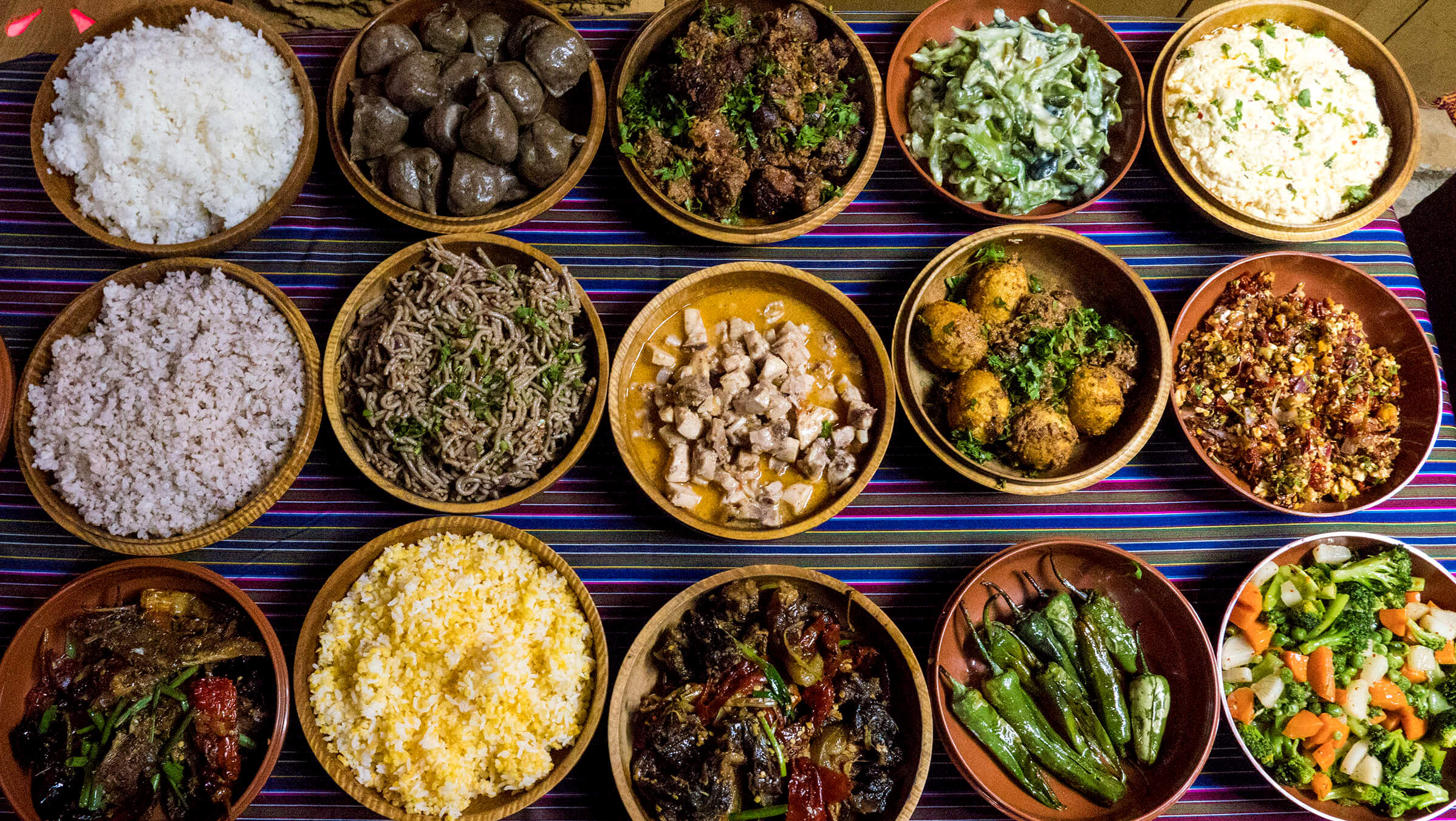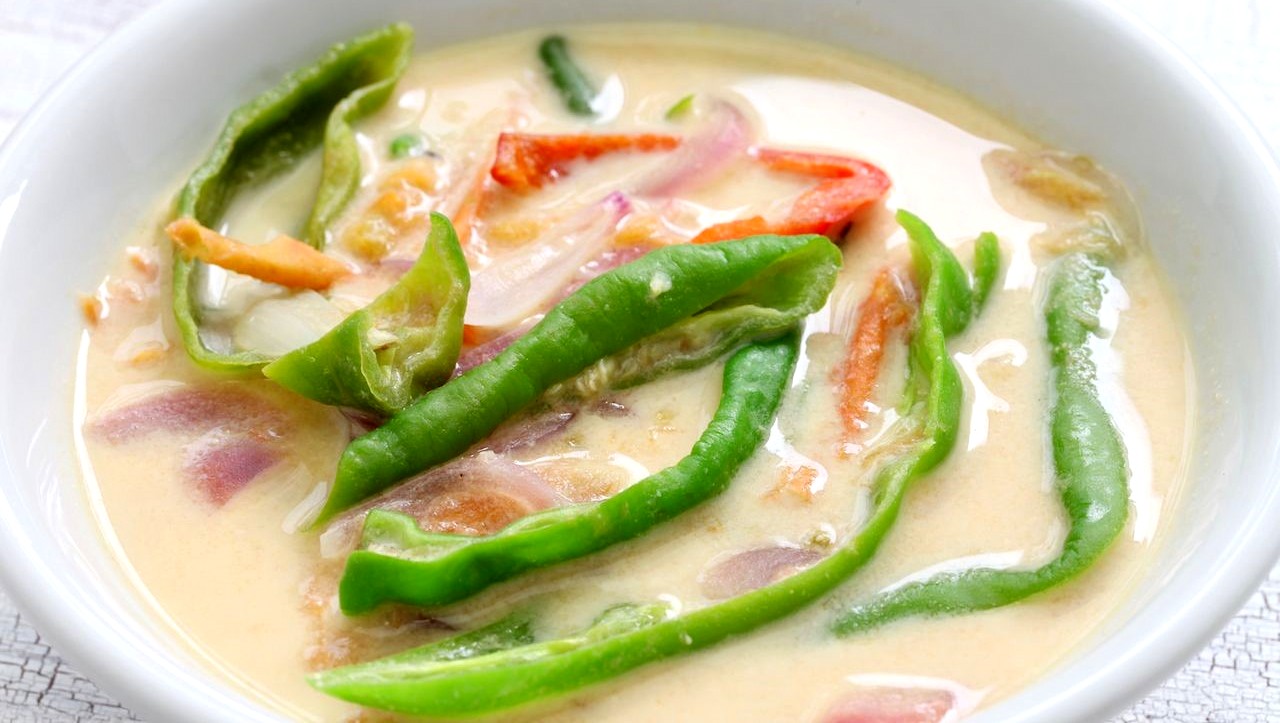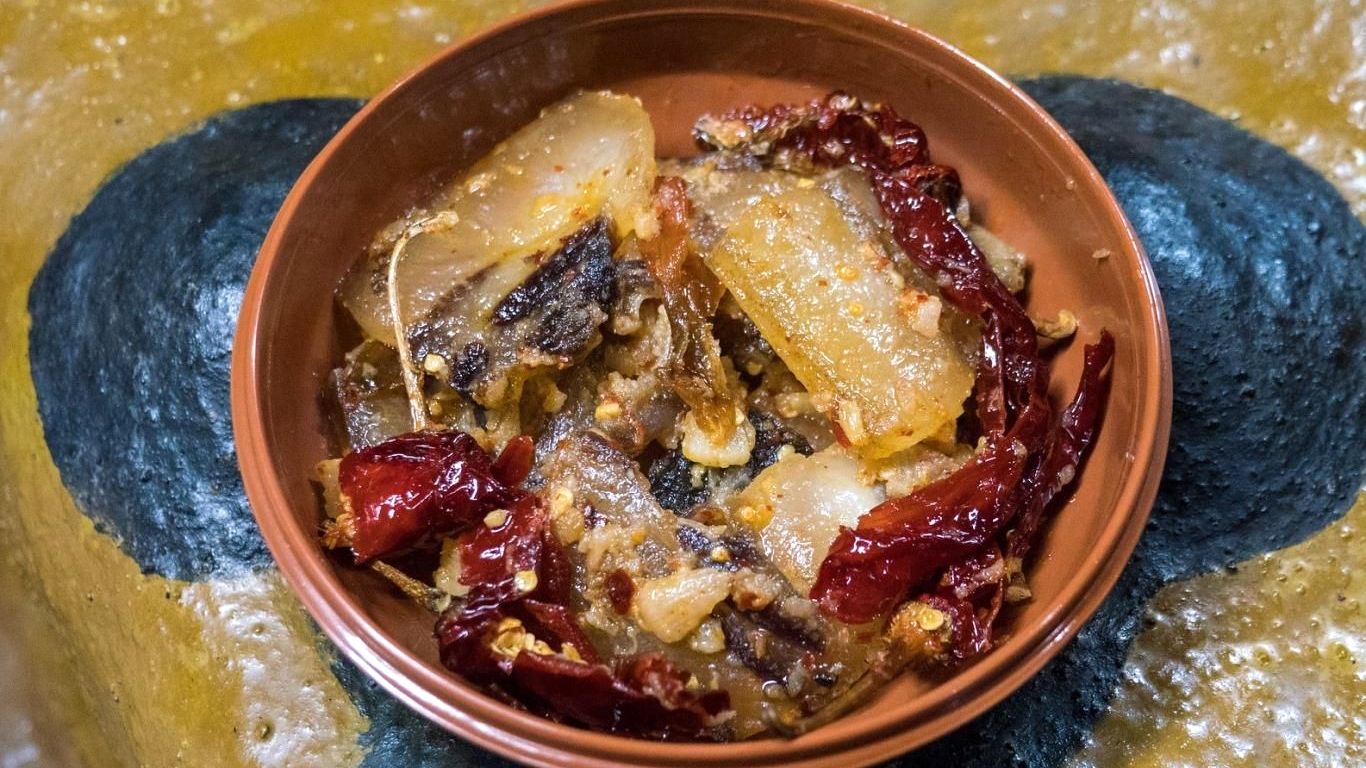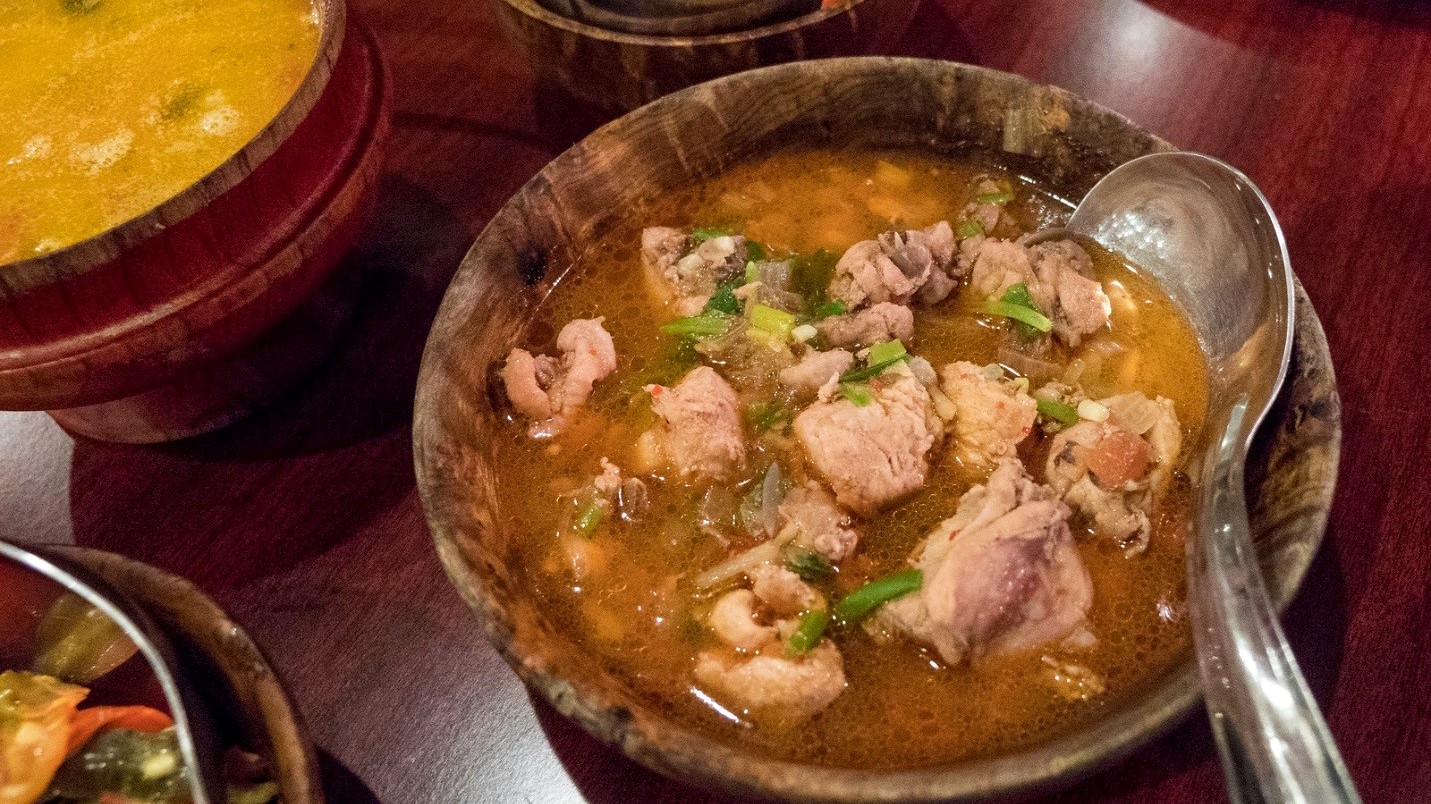Bhutanese Cuisine is a fascinating and flavorful journey into the heart of the Himalayas. Characterized by its bold use of spices, unique ingredients, and a deep-rooted connection to cultural traditions, Bhutanese cuisine offers an array of delightful experiences to its explorers. From the fiery Ema Datshi, the beloved national dish made with chilies and cheese, to the wholesome and nutritious Bhutanese Red Rice, each element of the cuisine tells a story of Bhutan's rich heritage. Incorporating a diverse range of Traditional Bhutanese Dishes, including both vegetarian and meat options, the cuisine reflects the harmonious balance between nature and spirituality that is central to Bhutanese life. Whether it's through the simple yet satisfying Bhutanese Street Food, the ceremonial Bhutanese Festive Foods, or the comforting sip of Bhutanese Butter Tea, Bhutanese cuisine is a testament to the country's ethos of happiness and well-being. Furthermore, the inclusion of traditional beverages like Ara (Bhutanese Rice Wine) adds to the uniqueness of the culinary experience. Delving into Bhutanese Cuisine is not just about savoring flavors; it's an immersive journey into Bhutan's rich Food Culture and Traditions.
We pride ourselves on being the best company for an authentic and immersive experience in Bhutanese Cuisine. Our deep understanding and appreciation of Bhutan’s rich culinary culture allow us to offer our clients an unparalleled journey into the heart of Bhutan's food traditions. From arranging visits to local homes for a taste of the fiery Ema Datshi to guiding you through the vibrant markets for a sampling of Bhutanese Street Food, we ensure every aspect of your culinary adventure is memorable. Our expert guides not only introduce you to the array of Traditional Bhutanese Dishes but also immerse you in the stories and traditions behind them. With Luxury Holidays Nepal, you don’t just taste the food; you experience the soul of Bhutan through its cuisine. Our commitment to providing an authentic and luxurious experience makes us the best choice for anyone looking to explore the unique and flavorful world of Bhutanese Cuisine.
Staple Ingredients
Bhutanese Cuisine is characterized by a range of staple ingredients that are integral to its unique flavors and culinary identity. These ingredients not only define the traditional dishes but also reflect Bhutan's agricultural practices and cultural heritage. Here's an overview of the key staple ingredients in Bhutanese cuisine:

-
Red Rice: Perhaps the most distinctive staple is Bhutanese Red Rice. Grown primarily in the Paro Valley, this rice variety is irrigated with mineral-rich glacier water. It has a nutty flavor, a somewhat chewy texture, and cooks faster than most other rice varieties. Red rice is a common accompaniment to many Bhutanese dishes.
-
Chilies: Chilies are not just a spice but a central ingredient in many Bhutanese dishes. They are used extensively in various forms - fresh, dried, or powdered. The Bhutanese love for chilies is evident in their national dish, Ema Datshi, which prominently features chilies.
-
Buckwheat: In the colder regions of Bhutan, like Bumthang, buckwheat is a staple grain. It's used to make a variety of foods including noodles (Putta), pancakes, and other traditional dishes. Buckwheat is valued for its hardiness and nutritional properties.
-
Maize: Another important grain in the Bhutanese diet is maize. It's used to make corn-based dishes and is a staple food, especially in the eastern parts of Bhutan. Maize is often ground into flour and used in traditional Bhutanese cooking.
-
Cheese (Datshi): Cheese, especially the homemade variety known as Datshi, is a key ingredient in many Bhutanese dishes. Made from cow's or yak's milk, it's used in various cheese-based dishes like Ema Datshi, Kewa Datshi (potatoes and cheese), and Shamu Datshi (mushrooms and cheese).
-
Butter and Dairy Products: Dairy products, particularly butter, are used extensively in Bhutanese cuisine. Butter is a key ingredient in the preparation of the Bhutanese butter tea (Suja), and is also used in other dishes for its rich flavor.
-
Meat: Meat, including beef, pork, chicken, and yak, is commonly consumed in Bhutan. It is often dried or smoked for preservation and used in various stews and curries.
-
Herbs and Spices: Various herbs and spices like Sichuan pepper, garlic, ginger, and turmeric are used to add flavor and depth to Bhutanese dishes. The use of these ingredients reflects the influence of neighboring culinary traditions, particularly from India and China.
-
Vegetables and Fruits: Locally grown vegetables and fruits play a significant role in the Bhutanese diet. Common vegetables include spinach, radishes, turnips, onions, and tomatoes, while apples, oranges, and various berries are among the popular fruits.
These staple ingredients of Bhutanese Cuisine not only provide insight into the nation's dietary patterns but also offer a window into Bhutan's rich cultural tapestry and its deep connection with nature and sustainability.
Spicy Flavors
One of the most distinctive characteristics of Bhutanese Cuisine is its bold and spicy flavors. The use of chilies in Bhutanese cooking is not just for seasoning but is an integral part of the cuisine. Here are some key aspects of the spicy flavors in Bhutanese cuisine:
- Chilies as a Staple: In Bhutan, chilies are considered a vegetable rather than just a spice. This means they are used generously in many dishes, contributing to their distinctive heat. Red and green chilies, both fresh and dried, are common in Bhutanese kitchens.
- Ema Datshi - The National Dish: The epitome of Bhutanese love for spicy food is Ema Datshi, made with chilies (ema) and cheese (datshi). This dish, with its fiery and creamy flavor profile, showcases the central role of chilies in the cuisine.
 Ema Datshi
Ema Datshi-
Variety of Chilies: Bhutanese cuisine utilizes a variety of chilies, each imparting a different level of heat and flavor. From the small, round, and extremely hot local chilies to the larger, milder ones, the use of chilies is diverse.
-
Incorporation in Most Dishes: Chilies find their way into a wide array of dishes, from main courses to side dishes and even in some snacks and condiments. They are often used in combination with other spices to create complex flavor profiles.
-
Cultural Significance: The use of chilies in Bhutanese cooking goes beyond taste; it holds cultural significance. The Bhutanese believe that spicy food helps in tempering the cold weather conditions prevalent in the Himalayas and aids in digestion.
-
Regional Variations: The use and preference of chilies can vary across different regions in Bhutan. While some areas may prefer extremely spicy dishes, others may have a more subdued approach to using chilies.
-
Adaptation for Tourists: Recognizing that the level of spice might not be suitable for all palates, especially tourists, many Bhutanese restaurants and eateries are willing to adjust the spice levels in their dishes to cater to a wider audience.
The spicy flavors of Bhutanese cuisine are a hallmark of the country's culinary identity, reflecting its cultural richness and the Bhutanese people’s love for vibrant and hearty flavors.
Cheese-Based Dishes
Cheese-based dishes in Bhutanese Cuisine represent a unique and essential aspect of this Himalayan nation's culinary identity. The use of cheese, particularly the local variety known as 'Datshi', plays a pivotal role in many traditional Bhutanese recipes. Here are some key points about these cheese-based dishes:
-
Ema Datshi - The Quintessential Dish: The most famous cheese-based dish in Bhutan is Ema Datshi, which translates to 'chili and cheese'. This iconic dish is a staple in every Bhutanese household and is made with a combination of local chilies and a generous amount of Datshi cheese, creating a spicy, creamy, and utterly comforting dish.
-
Variety of Datshi Dishes: Beyond Ema Datshi, there are several other popular Datshi dishes, such as Kewa Datshi (potato and cheese) and Shamu Datshi (mushroom and cheese). These dishes follow a similar pattern, combining Datshi cheese with a vegetable to create a hearty and flavorful stew.
-
Homemade Cheese: The cheese used in Bhutanese dishes is traditionally homemade, crafted from the milk of cows or yaks. This cheese is fresh, unaged, and has a distinctively sharp and somewhat tangy flavor, setting it apart from Western-style cheeses.
-
Role in Bhutanese Diet: Cheese-based dishes are a crucial part of the Bhutanese diet, providing essential nutrients, particularly in the colder, high-altitude areas where vegetables can be scarce. They are often served with staples like red rice or maize.
-
Cultural Significance: Cheese dishes in Bhutan are more than just a food item; they are a part of the cultural fabric. The process of making cheese and preparing these dishes is passed down through generations, reflecting the country's agrarian lifestyle and culinary traditions.
-
Regional Variations: Different regions in Bhutan have their own versions of cheese-based dishes, influenced by local ingredients and culinary preferences. This regional variation adds to the richness and diversity of Bhutanese cuisine.
-
Innovative Fusion: Modern Bhutanese chefs and restaurants are increasingly experimenting with traditional cheese-based recipes, introducing new ingredients and techniques while still honoring the essence of the classic flavors.
-
Nutritional Value: Bhutanese cheese dishes are not only flavorful but also nutritious, providing a good balance of protein, fat, and carbohydrates, especially important in the energy-demanding climate of Bhutan.
Cheese-based dishes are a cornerstone of Bhutanese Cuisine, reflecting the country's culinary ingenuity, cultural heritage, and the natural bounty of its land. These dishes offer a unique and delightful experience for anyone looking to explore the flavors of Bhutan.
Meat and Vegetarian Dishes
Meat Dishes in Bhutanese Cuisine
- Phaksha Paa: This is a traditional pork dish cooked with spicy red chilies and radishes. Dried pork is often used, which adds a unique texture and flavor to the dish.
 Phaksh Paa
Phaksh Paa-
Sikam Paa: Made from dried beef, Sikam Paa is another classic Bhutanese dish. The beef is typically hung to dry for several weeks and then cooked with chilies and other vegetables.
-
Yak Meat Dishes: In the higher altitude areas of Bhutan, yak meat is a common ingredient. It's used in various stews and curries, prized for its rich flavor and nutritional value.
-
Sha Kam: Dried beef, often prepared with dried chilies, is a staple in many Bhutanese meals. Sha Kam can be both a main dish and a side dish, enjoyed with red rice or other staples.
- Jasha Maru: A popular chicken curry, Jasha Maru is made with diced chicken, tomatoes, ginger, garlic, and a mix of Bhutanese spices. It's a common dish in Bhutanese households and is known for its flavorful and aromatic gravy.
 Jasha Maru
Jasha Maru
Vegetarian Dishes in Bhutanese Cuisine
-
Ema Datshi: While often made with chilies and cheese, Ema Datshi can also be prepared in a purely vegetarian form, excluding any animal products except for cheese.
-
Kewa Datshi: This dish is a comforting blend of potatoes and cheese, seasoned with a modest amount of spices. It’s a staple vegetarian dish in Bhutanese cuisine.
-
Shamu Datshi: Made with mushrooms and cheese, Shamu Datshi is a rich and creamy dish that highlights the earthy flavors of mushrooms, balanced with the tanginess of the cheese.
-
Red Rice and Vegetables: Simple yet nutritious, meals comprising red rice and a variety of seasonal vegetables are common in Bhutanese vegetarian cuisine.
-
Vegetable Momos: These are dumplings filled with a mixture of vegetables and served with a spicy tomato-based sauce. They are a popular snack and a vegetarian favorite.
-
Vegetable Curries: Various vegetable curries made with spinach, pumpkin, beans, and other locally grown vegetables are part of the Bhutanese vegetarian repertoire.
The diversity in Bhutanese Cuisine, encompassing both meat and vegetarian dishes, is not just a reflection of the country's culinary skills but also its cultural ethos and agrarian lifestyle. These dishes offer a harmonious blend of flavors and textures, making Bhutanese food a unique and satisfying culinary experience.
Use of Local and Organic Produce
The use of local and organic produce is a cornerstone of Bhutanese Cuisine, reflecting the country's deep commitment to sustainability and natural harmony. This approach to food is integral to Bhutan's culinary identity and plays a significant role in the flavors and quality of its dishes. Here are some key aspects of how local and organic produce shapes Bhutanese cuisine:
-
Commitment to Organic Farming: Bhutan has made significant strides towards becoming the world's first wholly organic nation. This commitment to organic farming means that most ingredients used in Bhutanese cuisine are free from synthetic pesticides and fertilizers, enhancing their natural flavors and nutritional value.
-
Freshness of Ingredients: The reliance on locally sourced produce ensures that the ingredients are fresh. In Bhutan, it's common for meals to be prepared with vegetables and herbs picked the same day, which greatly enhances the taste and quality of the food.
-
Seasonal Eating: Bhutanese cuisine is closely tied to the seasons, with dishes often being prepared using ingredients that are in season. This not only guarantees the freshness of the food but also means that the cuisine is constantly changing and adapting throughout the year.
-
Diverse Agricultural Practices: Due to Bhutan's varied topography and climate, different regions of the country grow different types of produce. This diversity is reflected in regional variations in the cuisine, with certain areas specializing in specific ingredients like red rice, buckwheat, or certain types of vegetables and fruits.
-
Sustainability and Self-Sufficiency: The focus on local and organic produce is also part of a broader national ethos of environmental sustainability and self-sufficiency. This philosophy is deeply ingrained in Bhutanese culture and is evident in their food practices.
-
Health Benefits: Consuming organic produce has health benefits, as it reduces the intake of chemicals and pesticides. Bhutanese cuisine, with its emphasis on fresh, organic ingredients, is thus considered not only delicious but also nourishing.
-
Supporting Local Farmers: By using local produce, Bhutanese cuisine supports local farmers and communities, ensuring that the benefits of tourism and the restaurant industry extend to the rural population.
-
Culinary Identity: The use of local and organic produce is not just a health or environmental choice; it's a key part of Bhutan’s culinary identity. It reflects the nation's respect for nature and its commitment to preserving its agricultural heritage.
The use of local and organic produce in Bhutanese Cuisine is a reflection of the country's values and traditions, contributing significantly to the authenticity, flavor, and nutritional value of its food.
Influence of Buddhism
The influence of Buddhism on Bhutanese Cuisine is profound and multifaceted, deeply interwoven with the nation's spiritual practices and cultural ethos. Buddhism, being the predominant religion in Bhutan, shapes not only the dietary habits but also the philosophical approach to food and cooking in Bhutanese society. Here are some key ways in which Buddhism influences Bhutanese cuisine:
-
Vegetarianism and Compassion for Living Beings: Buddhism’s emphasis on non-violence and compassion for all living beings has a significant impact on dietary choices. Many Bhutanese, especially monks and spiritual practitioners, adhere to vegetarianism, abstaining from meat and emphasizing plant-based foods.
-
Mindful Eating Practices: Buddhism promotes mindfulness and conscious living, which extends to eating habits. Meals in Bhutan are often consumed in a mindful manner, with an appreciation for the food, its origins, and the effort involved in its preparation.
-
Fasting and Religious Observances: Certain Buddhist traditions and days of religious significance involve fasting or abstaining from specific foods. These practices influence the food consumed on particular days and are observed by devout Buddhists throughout Bhutan.
-
Ritual Offerings: Food plays a role in Buddhist rituals and ceremonies in Bhutan. Offerings of food, often simple, unprocessed items like fruits and rice, are common in temples and monasteries as a sign of respect and devotion.
-
Monastic Cuisine: The cuisine in Buddhist monasteries, which forms a part of Bhutanese culinary culture, is typically vegetarian, simple, and focused on nutritional needs rather than indulgence. This monastic diet has influenced Bhutanese cuisine, emphasizing meals that are wholesome and balanced.
-
Seasonal and Sustainable Practices: Buddhism’s respect for nature is reflected in the seasonal and sustainable approach to food in Bhutan. This includes using locally sourced and organically grown produce, in alignment with the natural cycles and ecological balance.
-
Restrictions on Certain Foods: In line with Buddhist teachings, certain foods are traditionally avoided or consumed minimally in Bhutanese cuisine. This includes avoiding foods that are considered overly stimulating or harmful to one's health and spiritual well-being.
-
Cultural Festivals and Food: Bhutanese Buddhist festivals often involve the preparation of special foods and communal meals. These festivals showcase unique dishes that hold religious and cultural significance.
The influence of Buddhism on Bhutanese Cuisine is a testament to how deeply food and spirituality are intertwined in Bhutanese culture. This relationship fosters a cuisine that is not only flavorful but also imbued with ethical, spiritual, and ecological awareness.
Seasonal and Regional Variations
Bhutanese Cuisine is characterized by its seasonal and regional variations, which reflect the country's diverse climate, topography, and cultural influences. This diversity ensures a rich and varied culinary experience, deeply rooted in the local environment and traditions. Here are some key aspects of these variations:
Seasonal Variations
-
Availability of Ingredients: Bhutan's distinct seasons dictate the availability of fresh produce. Spring and summer bring an abundance of fresh fruits, vegetables, and greens, leading to lighter, vegetable-focused dishes. In contrast, the colder months see more root vegetables and preserved foods.
-
Preservation Techniques: Seasonal changes also influence food preservation methods. During harvest seasons, foods like chilies, vegetables, and meats are dried or fermented to be used in the winter months.
-
Festival Foods: Certain Bhutanese dishes are specifically prepared for festivals and religious occasions, which often occur in particular seasons. These dishes hold cultural significance and are integral to the celebratory feasts.
Regional Variations
-
Different Crops for Different Climates: The varied climate across Bhutan's regions means that different crops are grown in different areas. For example, red rice is predominant in the Paro Valley, while buckwheat and barley are more common in the higher, colder regions.
-
Local Specialties: Each region in Bhutan has its own culinary specialties. The central region, Bumthang, is famous for its buckwheat dishes, while the eastern regions are known for their spicy meat curries and maize-based dishes.
-
Influence of Neighboring Regions: Bhutan's proximity to India and Tibet influences its regional cuisines. The southern regions, closer to India, often have dishes with a more pronounced Indian flavor, while Tibetan influence is evident in the northern regions.
-
Cheese Variations: The type and preparation of cheese, a staple ingredient in Bhutanese cuisine, vary by region. Different areas produce their own unique varieties of cheese, which are used in local dishes.
-
Traditional Cooking Methods: Cooking methods and techniques can also vary regionally, influenced by the available resources, climate, and cultural practices.
-
Foraged Foods: In many regions, foraging for wild edibles, such as mushrooms and ferns, is common. These ingredients offer unique flavors and are often incorporated into local dishes.
-
Yak-Based Products in Higher Altitudes: In higher altitude regions, yak-based products like yak cheese and yak meat are more prevalent, reflecting the adaptation to the harsher, colder environment.
The seasonal and regional variations in Bhutanese Cuisine not only add to its richness and diversity but also showcase the deep connection between Bhutanese people, their land, and their culture. This intricate relationship is beautifully expressed through the variety of flavors and dishes found throughout the country.
Frequently Asked Questions for Bhutanese Cuisine
Q: What is the national dish of Bhutan?
A: The national dish of Bhutan is Ema Datshi, a spicy stew made with chilies and cheese. It's known for its bold flavor and is a staple in every Bhutanese household.
Q: Is Bhutanese food very spicy?
A: Yes, Bhutanese cuisine is generally quite spicy due to the liberal use of chilies in many dishes. The spice levels can often be adjusted to suit individual preferences, especially for tourists.
Q: Are there vegetarian options in Bhutanese Cuisine?
A: Absolutely. While meat dishes are common, there are also many vegetarian dishes in Bhutanese cuisine, influenced by Buddhist dietary practices. Dishes like Ema Datshi can be made vegetarian, and there are various vegetable-based stews and curries.
Q: What is a typical Bhutanese meal like?
A: A typical Bhutanese meal usually consists of a main dish (often a stew or curry), served with staples like red rice or buckwheat. It often includes a mix of spicy, savory, and sometimes cheesy flavors.
Q: What kind of meat is used in Bhutanese cooking?
A: Common meats in Bhutanese cuisine include chicken, beef, pork, and yak. These meats are often prepared in stews or curries with a rich mix of spices and chilies.
Q: What are some must-try dishes for a first-time visitor to Bhutan?
A: Besides the national dish Ema Datshi, visitors should try Phaksha Paa (pork with spicy red chilies), Jasha Maru (spicy chicken curry), and Bhutanese Red Rice. Also, trying traditional Bhutanese Butter Tea is a unique experience.
Q: Is alcohol consumed in Bhutan?
A: Yes, alcohol is consumed in Bhutan. The traditional alcoholic beverage is Ara, a type of rice wine, which is often homemade and served during special occasions and gatherings.
Q: How does Buddhism influence Bhutanese cuisine?
A: Buddhism influences Bhutanese cuisine in its emphasis on vegetarianism, ethical food choices, and the use of fresh, organic ingredients. It also affects dietary habits during religious festivals and fasts.
Q: Can I find international cuisine in Bhutan?
A: While traditional Bhutanese cuisine is predominant, in tourist areas, it's possible to find restaurants serving international cuisines, including Indian, Chinese, and Continental dishes.
Q: Are there any special dietary considerations to be aware of in Bhutan?
A: Visitors should be aware of the high spice levels in many dishes. Those with dietary restrictions or allergies should communicate their needs, as Bhutanese chefs are typically accommodating.
If you need any further information, please contact us by email: at [email protected], Phone: at +977- 985 100 5129 (WhatsApp)




